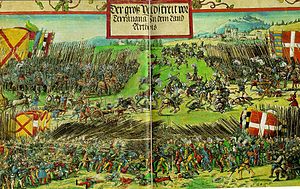| Battle of the Spurs | |||||||
|---|---|---|---|---|---|---|---|
| Part of the War of the League of Cambrai | |||||||
 Triumphzug Kaiser Maximilians, Georg Lemberger | |||||||
| |||||||
| Belligerents | |||||||
|
England Holy Roman Empire | France | ||||||
| Commanders and leaders | |||||||
|
Henry VIII Maximilian I Henry Bourchier George Talbot Lord Herbert |
Jacques Palice (POW) Charles IV of Alençon Louis d'Orléans (POW) Chevalier de Bayard (POW) | ||||||
| Strength | |||||||
| 30,000 overall, many fewer were engaged | 7,000 | ||||||
| Casualties and losses | |||||||
| Light | 3,000 killed, wounded, captured, or missing | ||||||
Location within France | |||||||
The Battle of the Spurs or (Second) Battle of Guinegate[1] took place on 16 August 1513. It formed a part of the War of the League of Cambrai of 1508 to 1516, during the Italian Wars. King Henry VIII of England and Emperor Maximilian I were besieging the French town of Thérouanne in Artois (now Pas-de-Calais). Henry's camp was at Guinegate (present-day Enguinegatte).[2] A large body of French heavy cavalry under Jacques de La Palice was covering an attempt by light cavalry to bring supplies to the besieged garrison. English and Imperial troops surprised and routed the French cavalry. The battle resulted in the precipitate flight and extensive pursuit of the French. During the pursuit, a number of notable French leaders and knights were captured. After the fall of Thérouanne, Henry VIII besieged and took Tournai.

